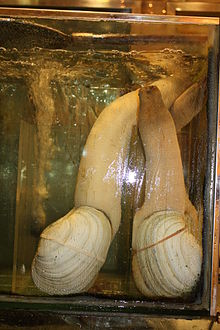 The Geoduck (“gooey duck”), Panopea generosa, is a species of very large saltwater clam, a marine bivalve mollusk in the family Hiatellidae.
The Geoduck (“gooey duck”), Panopea generosa, is a species of very large saltwater clam, a marine bivalve mollusk in the family Hiatellidae.
The shell of this clam is large, about 15 centimeters (5.9 in) to over 20 centimeters (7.9 in) in length, but the very long siphons make the clam itself very much longer than this: the “neck” or siphons alone can be 1 meter (3.3 ft) in length.
Etymology:
The unusual name of the clam is derived from a Lushootseed (Nisqually) word gʷídəq meaning “dig deep”, and its phonemically counterintuitive spelling is likely the result of poor transcription rather than anything having to do with ducks. Alternate spellings include gweduc, gweduck, goeduck, and goiduck. It is sometimes known as the mud duck, king clam, or when translated literally from the Chinese characters 象拔蚌 (Pinyin: xiàngbábàng, Yale: jeuhngbahtpóhng), the elephant-trunk clam.
Between 1983 and 2010, the scientific name of this clam was confused with an extinct clam, Panopea abrupta (Conrad, 1849), in the scientific literature.
Biology:
Native to the northwest coast of the United States and Canada (primarily Washington and British Columbia), the Geoduck is the largest burrowing clam in the world, weighing in at an average of one to three pounds (0.5–1.5 kg) at maturity, but specimens weighing over 15 pounds (7.5 kg) and as much as 2 meters (over 6.5 ft) in length are not unheard of.
A related species, Panopea zelandica, is found in New Zealand and has been harvested commercially since 1989. The largest quantities have come from Golden Bay in the South Island where 100 tons were harvested in one year.
There is a growing concern over the increase of parasites in the Puget Sound population of Geoduck. Whether these microsporidium-like parasitic species were introduced by commercial farming is being studied by Sea Grant. Research to date does indicate their presence, with these parasites passed directly to Chinese who consume raw Geoduck. Their long term effect on the human body is unknown at this time.
Geoducks are one of the longest-living organisms in the Animal Kingdom. The oldest recorded specimen was 168 years old, but individuals over 100 years old are rare. Scientists speculate that the Geoduck’s longevity is the result of low wear and tear. A Geoduck sucks water containing plankton down through its long siphon, filters this for food and ejects its refuse out through a separate hole in the siphon. Adult Geoducks have few natural predators, which may also contribute to their longevity. In Alaska, sea otters and dogfish have proved capable of dislodging Geoducks; starfish also attack and feed on the exposed Geoduck siphon.
Geoducks are broadcast spawners. A female Geoduck produces about 5 billion eggs in her century-long lifespan—in comparison, a human female produces about 500 viable ova during the course of her life. However, due to a low rate of recruitment and a high rate of mortality for Geoduck eggs, larvae and post-settled juveniles, populations are slow to rebound. In the Puget Sound, studies indicate that the recovery time for a harvested tract is 39 years.
Geoduct Industry:
The world’s first Geoduck fishery was created in 1970, but demand for the half-forgotten clam was low due to its texture. Today, they sell in Asia for up to US$168/lb (US$370/kg) its large, meaty siphon is prized for its savory flavor and crunchy texture. Geoduck is incorrectly regarded by some as an aphrodisiac due to its phallic shape. It is very popular in China, where it is considered a delicacy, mostly eaten cooked in a fondue-style Chinese hot pot. In Korean cuisine, Geoducks are eaten raw with spicy chili sauce, sautéed, or in soups and stews. In Japan Geoduck is prepared as raw sashimi, dipped in soy sauce and wasabi. On Japanese menus, Geoduck is called mirugai or mirukuigai and is considered to have a texture similar to an ark shell (known in Japanese as akagai). It is worth noticing that although mirugai is sometimes translated to English as “giant clam”, it is distinguished from himejako sushi made from tridacna gigas.
The Geoduck’s high market value has created an $80 million U.S. industry, with harvesting occurring in both Washington state and the province of British Columbia. It is one of the most closely regulated fisheries in both countries; in Washington, Department of Natural Resources staff are on the water continually monitoring harvests in order to assure revenues are received, and the same is true in Canada where the Underwater Harvesters’ Association manages the Canadian Fishery in conjunction with Canada’s Department of Fisheries and Oceans. The Washington State Department of Health tests water and flesh in order to assure clams are not filtering and holding pollutants, an ongoing problem.
As of the 2007 season, advances in the testing system for contaminated clams have allowed Geoduck harvesters to deliver live clams more consistently. The new testing system determines the viability of clams from tested beds before the harvesters fish the area. Previous methods tested clams after harvest. This advancement has meant that 90 percent of clams were delivered live to market in 2007. In 2001 only 10 percent were live. Because Geoduck have a much higher market value live—an additional $2 to $3 per pound—this development has helped to stimulate the burgeoning industry.